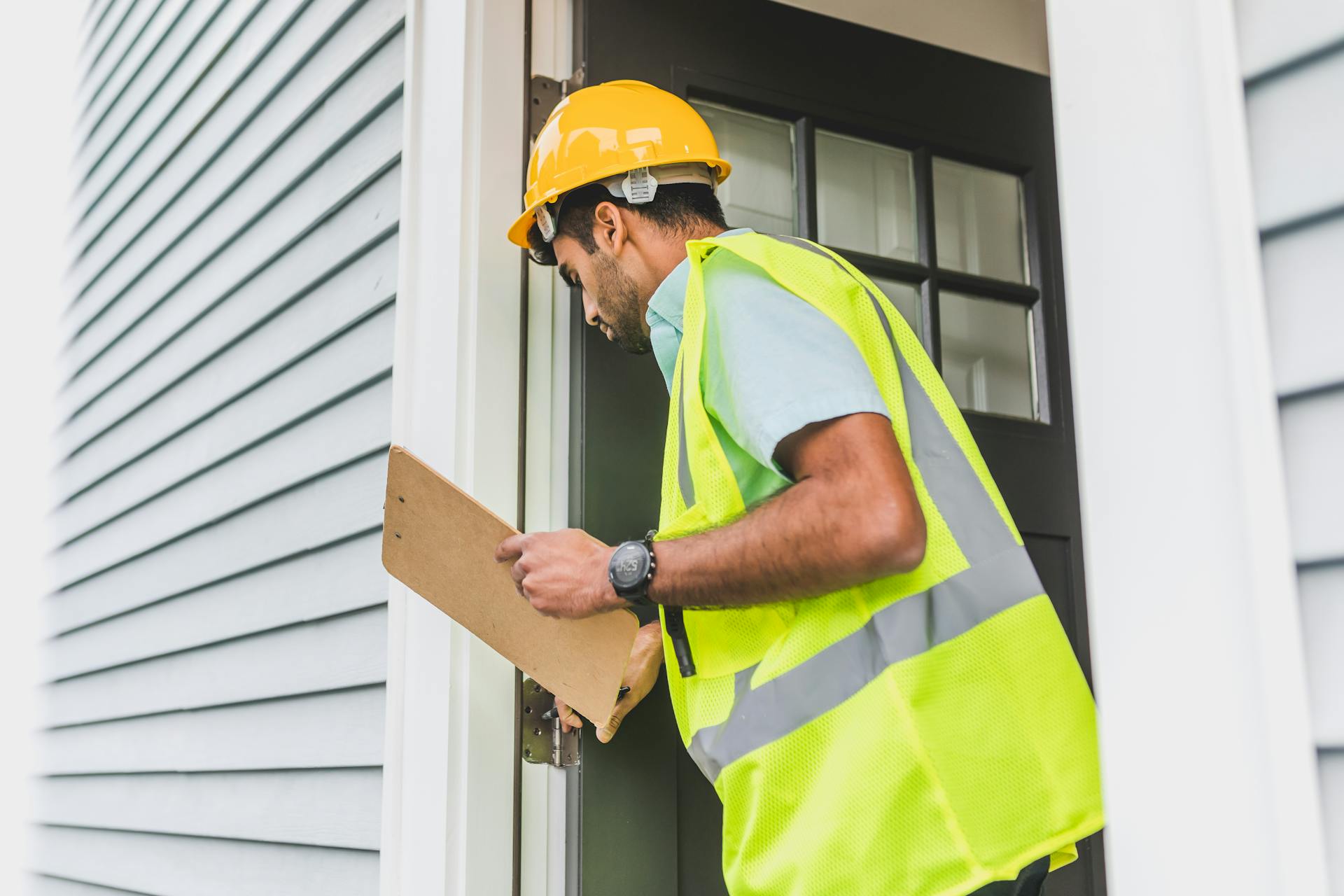
Navigating a house insurance claim can be a daunting task, but understanding what to expect can make the process smoother. You'll need to notify your insurer within a specific timeframe, usually 30 days, to avoid any potential issues with your claim.
Your insurer will send an adjuster to assess the damage and determine the cause. This is usually done within a few days of your notification.
The adjuster will take photos and notes, and may ask you questions about the incident. Be prepared to provide detailed information about what happened.
The adjuster's report will form the basis of your claim, so it's essential to cooperate fully.
A different take: Will Insurance Cover a House Fire Started by a Cigarette
Understanding House Insurance Claims
Filing a homeowners insurance claim is a straightforward process that involves contacting your insurance company's claims department and providing details about the incident.
You'll need to report the incident and provide information about the damage to the claims department, who will then guide you through the process and assign a claims adjuster.
The claims process involves several steps, including assessment by a claims adjuster, reviewing policy coverage, estimating the loss, and discussing the settlement.
In Utah, claims related laws and rules apply to property and casualty insurance, but these laws are not exhaustive and are meant to provide a general understanding of the statutes.
The insurance company will assess the damage and estimate the loss to determine the extent of the coverage.
Preparing for a Claim
Contact your insurance company's claims department as soon as possible to report the incident and get guidance on the process. They will assign a claims adjuster to assess the damage and guide you through the next steps.
Save all receipts for temporary repairs, as the initial payment from your insurer may not cover the full cost of repairs. This includes receipts for materials and labor.
Document the damage by taking photos and creating an inventory of damaged items. This will help you and your insurer keep track of everything that needs to be repaired or replaced.
Here's a checklist to help you prepare for a claim:
- Call your insurance company or agent with your policy number and other relevant information.
- Take photographs/video of the damage.
- Save all receipts, including those from temporary repairs.
Secure Your Property
Securing your property is a crucial step in preparing for a claim. To minimize damage and prevent further harm, take reasonable steps to mitigate damages.
A burglar alarm monitored by a central station can lower your annual premiums by 5% or more. This is a great incentive to invest in a security system.
Smoke alarms are a must-have, and installing them in older homes can save you 10% or more in annual premiums. It's amazing how much of a difference a simple smoke alarm can make.
Mitigating damages is a key part of your insurance policy. This includes taking commonsense steps like covering a leaky roof with a plastic tarp until it can be repaired.
To justify your claim, take photos of the damage before you make any repairs. This will help your insurance company understand the extent of the damage.
Here are some specific steps you can take to mitigate damages:
- Stop the smoldering by contacting the fire department if your property is still burning after a fire.
- Board it up by placing boards across open and accessible parts of your property to prevent vandalism.
- Be vigilant by keeping a close eye on your property and checking for new problems.
By taking these steps, you can help protect your property and ensure a smoother claims process.
Document the
Document the damage to your property by taking photos and creating an inventory of damaged items. This will give you and your insurer a record of everything that needs to be repaired or replaced.
Having a clear record of damaged items will also help you receive fair compensation in case of covered losses. This is especially true for more expensive items, where getting pictures of labels and model numbers can make a big difference.
Create a home inventory using a template or app to make the process easier. Some popular home inventory apps and templates can be found online.
Taking photos and creating an inventory of damaged items should include pictures of labels and model numbers, especially for more expensive items. This will help ensure accurate valuation of your possessions.
Save all receipts, including those from temporary repairs, to document your expenses. This will also help you prove what you actually spent on repairs.
Here's a checklist to help you document the damage:
- Take photographs/video of the damage.
- Make an inventory of damaged items.
- Get pictures of labels and model numbers for more expensive items.
- Save all receipts for repairs and temporary fixes.
Filing a Claim
Filing a claim is a crucial step in the home insurance process. You can submit a claim by contacting your insurance company's claims department, either by calling or sending an email.
To initiate the claims process, you'll need to report the incident to your insurance company as soon as possible. This can be done by calling your agent or sending an email.
You'll be asked to submit a "proof of loss claim", which requires itemizing your losses and listing their value. Delaying notification of your insurance company may put you at the back of the line for an adjuster to inspect your property.
Get organized by taking notes during phone calls and keeping records of communication, estimates, invoices, bills, permits, and contracts for repairs. Never part with an original document.
Insurance companies are required to handle claims in a timely manner, and in California, they must send a "notice of intentions" within 30 days of receiving your claim. If there's no dispute over coverage, you're entitled to payment within that time.
You can submit a claim online, through an app, via your agent, or by calling the company. Reporting a claim right away can put money in your pocket faster.
Additional reading: Claim Insurance Company
Claim Process and Timeline
The claims process for a homeowners insurance claim is relatively straightforward. First, you'll need to report the incident to your insurance company's claims department.
They will guide you through the process, assign a claims adjuster, and assess the damage. This is usually done in a timely manner, often within a few days of filing the claim.
The claims adjuster will assess the damage and estimate the loss, which is a crucial step in determining the extent of the coverage. This process typically involves reviewing policy coverage to ensure everything is in order.
Ultimately, the claims process involves discussing the settlement and receiving payment for repairs or replacements. Once the settlement is agreed upon, you can expect to receive payment from your insurance company.
Consider reading: Insurance Claim Settlement
Insurance Policy and Coverage
A homeowners policy typically has standard elements that provide coverage for various costs, including main coverage areas such as dwelling, personal property, and liability.
These standard elements can be customized to fit individual needs, but they're essential for understanding what's covered in a policy.
Homeowners insurance policies are standardized into different types, designated HO-1 through HO-8, offering varying levels of protection depending on the residence being covered.
FAIR plans, for example, offer basic coverage to property owners in high-risk zones, serving as a last-resort option.
There are essentially three levels of coverage, with many states offering specialized plans like FAIR.
Personal liability coverage is a standard part of homeowners insurance, covering legal expenses if you're sued for injuries or property damage on your property.
For another approach, see: Gds Claims - Public Adjuster
What a Policy Offers
A homeowners policy typically has standard elements that provide coverage for various costs.
Each policy has main coverage areas that are discussed below.
Personal liability coverage is a standard part of homeowners insurance, covering legal expenses if you're sued for injuries or property damage on your property.
Some policies may cover certain kinds of damage from natural disasters, but not others, and coverage can vary depending on where you live and how your home is built.
A guaranteed replacement cost/value policy pays for the cost to repair or rebuild your home, even if it's more than your policy limit, and offers a cushion if construction prices increase.
Liability coverage protects you from lawsuits filed by others, including your pets, and can cover medical expenses, lost wages, and pain and suffering.
Actual Cash Value
Actual Cash Value is a crucial concept to understand when it comes to insurance policies. Actual Cash Value (ACV) covers the cost of your house plus the value of your belongings after deducting depreciation.
This means ACV is not the original price you paid for your items, but rather their current value. Some policies may contain a recoverable depreciation clause.
This clause allows you to claim the value of the depreciation along with the ACV, which can be a significant advantage. You'll be able to recover more of your losses if you need to repair or rebuild your home.
Replacement value policies, on the other hand, cover the actual cash value of your home and possessions without deducting depreciation. This means you can repair or rebuild your home up to the original value.
A unique perspective: Depreciation Insurance Claim Auto
What's Not Covered
Interior water damage from a storm is not covered if there's no damage to the roof or walls of your home.
Damage as a result of a flood is not covered under most standard homeowners policies.
Some insurers offer endorsements for certain coverages not covered under the standard homeowner policy, so it's a good idea to check with your agent or company.
Removal of fallen trees is not covered if the trees don't land on and damage your home.
Food spoilage due to a power outage is not covered under standard homeowners policies.
Water damage from backed-up drains or sewers is not covered under most standard homeowners policies.
For another approach, see: What Not to Say When Filing a Homeowners Insurance Claim
Managing Costs and Expenses
Managing costs and expenses can be a challenge after a house insurance claim. You can ask your insurer for an advance against your eventual claim to cover living costs, such as replacing basic necessities.
You'll need to keep receipts for everything you buy and be reasonable about what you replace, so you don't end up paying the difference. For example, if you lost khakis and a blazer, don't head out to buy Armani suits.
If your home is badly damaged and you can't live in it, your insurance company may help with living expenses, such as hotel stays and restaurant meals.
Living Expenses Help
If your home is badly damaged, your insurance company may be able to help with living expenses. Loss of use coverage is part of a standard homeowners policy and will pay for things like hotel stays and restaurant meals.
You'll want to keep all receipts to make sure you're fully reimbursed for this part of your homeowners insurance claim. Save those receipts, it's essential to have them.
In some states, like Texas, homeowners insurance companies aren't allowed to charge you more if your claim stems from a natural cause, such as weather. Check with your state's department of insurance for specifics about where you live.
If you're unable to live in your home, your insurance company may bring a check to you wherever you're staying, be it a hotel or a friend's house. Just be reasonable with your purchases and don't try to get reimbursed for something you don't really need.
Additional reading: Is There a Public Adjuster on This Check
Raise Your Deductible
Raising your deductible is a way to lower your annual premiums, but be aware that claims under a few hundred dollars will likely fall on you, adding up over time.
A higher deductible can lead to a significant reduction in premiums, making it a tempting option for those looking to save money.
Some insurance providers offer a buyback deductible adder to a policy, which can reduce the deductible associated with an event, but this will cost you a higher premium.
This adder can be a worthwhile investment if you have a history of minor claims, but it's essential to weigh the cost against the potential benefits.
A deductible of a few hundred dollars may not seem like a lot, but it can add up quickly, especially if you have multiple small claims in a year.
Frequently Asked Questions
Is it worth claiming on home insurance?
Claiming on home insurance may not always raise your premiums, but larger claims are more likely to cause an increase. Smaller claims, like replacing a laptop, typically have little to no impact on your insurance costs.
What is the 80% rule in homeowners insurance?
The 80% rule in homeowners insurance requires policyholders to cover at least 80% of their home's total replacement value to ensure full reimbursement for damages. This ensures homeowners receive fair compensation for repairs or rebuilding.
What not to say when filing a home insurance claim?
When filing a home insurance claim, avoid using phrases that introduce doubt, such as "I think" or "It might have been." Stick to clear, confident statements supported by evidence and records to ensure a smooth claims process.
Sources
- https://www.investopedia.com/insurance/homeowners-insurance-guide/
- https://oci.georgia.gov/insurance-resources/home
- https://www.nolo.com/legal-encyclopedia/dealing-with-insurance-after-disaster-29640.html
- https://www.nerdwallet.com/article/insurance/home-damage-claims
- https://insurance.utah.gov/consumers/home-insurance/home-claims-info/
Featured Images: pexels.com


